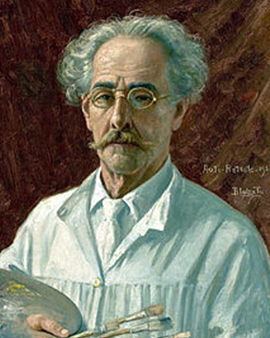


Some painters were so multi-talented as artists and great minds that one involuntarily asks oneself when and where they actually had time to paint. Benedito Calixto de Jesus, a painter from Brazil, is presented on the Portuguese Wikipedia page as "painter, draughtsman, photographer, historian, decorator, cartographer and amateur astronomer" - quasi a polymath of his time. Born in 1853 in Itanháem not far from Sao Paulo, he did not attend the "Imperial Academy of Fine Arts" in Rio de Janeiro, as most artists of his time did; Calixto was a self-taught artist and always remained attached to his home region Sao Paulo. He lived in the port city of Santos since 1881 and was considered (long before the era of the footballer Pelé) as its most famous inhabitant.
Benedito Calixto painted mainly townscapes and landscapes, he had a soft spot for simple people in traditional or festive clothing. But his most famous works are dedicated to historical or contemporary subjects. These include "The Proclamation of the Republic", in which the ceremony is shown at the moment of the salute (Emperor Pedro II had been overthrown by a military plaster in 1889) and "The Shipwreck of the SS Sirio", which shows a group of praying priests amidst desperate people. On this ship, near Cartagena (Spain) in 1906, about 200 people, mostly Italian emigrants on their way to Argentina, lost their lives. A group of Catholic dignitaries (including the Brazilian archbishops of Sao Paulo and Porto Alegre) behaved in an exemplary manner, blessing the passengers and paying for their perseverance, in part with their lives, while the captain and parts of the crew took themselves to safety at the first opportunity. In Italy, the catastrophe remained unforgotten, the last time it was discussed was in 2012 on the occasion of the "Costa Concordia affair".
Calixto's portraits of historical personalities were also in great demand. Among his masterpieces are those of Domingo's Jorge Velho (one of the knights of fortune who discovered and conquered the hinterland of Sao Paulo around 1700) and Martim Alfonso de Sousa (founder of the first settlement not far from Sao Paulo and the first governor of Brazil for the Portuguese crown) or the statesman and mineralogist José Bonifácio Andrade e Silva.
As befits his name (it means "Jesus' blessed chalice" in German), religious themes were the third pillar of Benedito Calixto de Jesus. Calixto died in 1927 at the age of 76 in Sao Paulo.

Some painters were so multi-talented as artists and great minds that one involuntarily asks oneself when and where they actually had time to paint. Benedito Calixto de Jesus, a painter from Brazil, is presented on the Portuguese Wikipedia page as "painter, draughtsman, photographer, historian, decorator, cartographer and amateur astronomer" - quasi a polymath of his time. Born in 1853 in Itanháem not far from Sao Paulo, he did not attend the "Imperial Academy of Fine Arts" in Rio de Janeiro, as most artists of his time did; Calixto was a self-taught artist and always remained attached to his home region Sao Paulo. He lived in the port city of Santos since 1881 and was considered (long before the era of the footballer Pelé) as its most famous inhabitant.
Benedito Calixto painted mainly townscapes and landscapes, he had a soft spot for simple people in traditional or festive clothing. But his most famous works are dedicated to historical or contemporary subjects. These include "The Proclamation of the Republic", in which the ceremony is shown at the moment of the salute (Emperor Pedro II had been overthrown by a military plaster in 1889) and "The Shipwreck of the SS Sirio", which shows a group of praying priests amidst desperate people. On this ship, near Cartagena (Spain) in 1906, about 200 people, mostly Italian emigrants on their way to Argentina, lost their lives. A group of Catholic dignitaries (including the Brazilian archbishops of Sao Paulo and Porto Alegre) behaved in an exemplary manner, blessing the passengers and paying for their perseverance, in part with their lives, while the captain and parts of the crew took themselves to safety at the first opportunity. In Italy, the catastrophe remained unforgotten, the last time it was discussed was in 2012 on the occasion of the "Costa Concordia affair".
Calixto's portraits of historical personalities were also in great demand. Among his masterpieces are those of Domingo's Jorge Velho (one of the knights of fortune who discovered and conquered the hinterland of Sao Paulo around 1700) and Martim Alfonso de Sousa (founder of the first settlement not far from Sao Paulo and the first governor of Brazil for the Portuguese crown) or the statesman and mineralogist José Bonifácio Andrade e Silva.
As befits his name (it means "Jesus' blessed chalice" in German), religious themes were the third pillar of Benedito Calixto de Jesus. Calixto died in 1927 at the age of 76 in Sao Paulo.
Page 1 / 1






